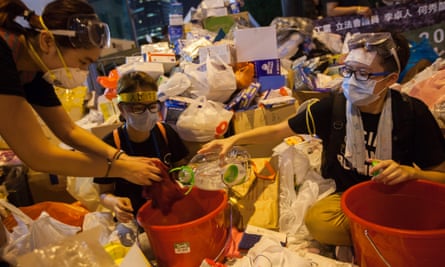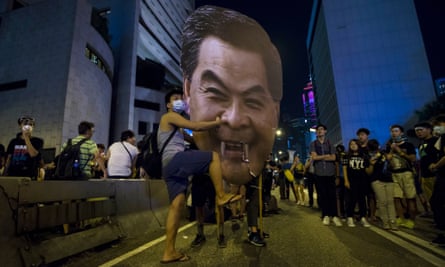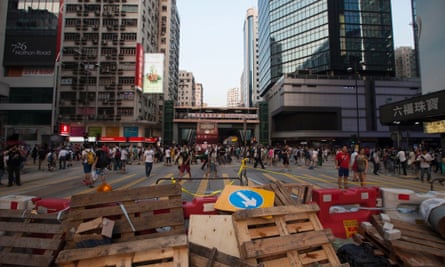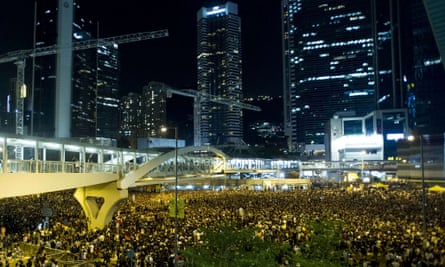Fresh waves of pro-democracy protesters have swept into the heart of Hong Kong, as a leader of the civil disobedience movement urged them to keep the momentum going until Wednesday’s national holiday.
Crowds blocked one of the city’s main roads on Monday from the financial area of Central to the bar district of Wanchai in what appeared to be the largest demonstration yet. Tens of thousands were packed so tightly into Admiralty, around the government headquarters, that it was hard to move through the masses gathered beneath the skyscrapers.
Some have dubbed it “the umbrella revolution” in reference to the umbrellas carried by protesters to ward off teargas and pepper spray attacks, and which also served to shelter them from the fierce sun earlier in the day.
With no sign of police force on Monday evening, the mood was festive rather than angry. Participants held up their smartphones to create a glittering sea of lights and joined in a mass rendition of Do You Hear The People Sing – the revolutionaries’ song from the musical Les Misérables. Many in the overwhelmingly young crowd wore black and sported yellow ribbons. Others had come straight from their offices in smart shirts; two teenage convent girls were still in their starched white uniforms.

“We hope it will continue until at least 1 October. Then we will announce new actions. It is not realistic for people to occupy Central forever,” Chan Kinman, one of the founders of Occupy Central with Peace and Love, told the Guardian.
“We have to be careful not to invite a backlash. Any civil disobedience has to be proportionate and at a certain time we have got to stop.”
But students have threatened to step up their protests if the government does not respond to their demands by Wednesday.
Hong Kong enjoys considerable autonomy under the “one country, two systems” framework and has long been promised universal suffrage for the election of the next chief executive in 2017. Protesters are furious at Beijing’s announcement of tight restrictions on candidates and see the decision as part of a broader attempt to erode the region’s freedoms and culture.
On Monday, both Britain and the US urged Hong Kong’s leaders to show restraint and adhere to the promise of universal suffrage. A Foreign Office spokesman said: “It is Britain’s long-standing position, as a co-signatory of the Sino-British Joint Declaration, that Hong Kong’s prosperity and security are underpinned by its fundamental rights and freedoms, including the right to demonstrate.”Precipitated by a student strike and expanding dramatically when police used teargas to try to clear the streets on Sunday, the protest movement has taken on a life of its own.
Many of those present on Monday did not identify themselves as supporters of Occupy Central, or even as protesters at all, and said only the police tactics had spurred them into action.
A cluster of young women in smart office clothes, clutching bulging plastic bags, appeared to be on a post-work shopping spree. But they stopped at a hardware store to buy goggles in case of a teargas attack. They were not the only ones. The hardware store sold dozens of pairs of goggles in just 15 minutes.

The marketing employees, who had bags full of crackers, plastic ponchos and water for protesters, had not planned to become involved, but said they felt they had to support them after seeing the scenes of billowing teargas on television. “Not everyone goes to the frontline. They need people to support them with resources,” said Helen Ng.
But she voiced some concern about the potential implications of the campaign: “We want to maintain the good image of Hong Kong. It’s a world city and we want to maintain the image and not, because of the protests, make people think the quality of the people is deteriorating.”
Chan said that while the movement was “not top-down, but bottom-up”, he believed the months that Occupy spent educating people in non-violent protest had been crucial in shaping events. Protesters had shown restraint even in the face of an unreasonable crackdown. “We can’t control it at the operational level, but the spiritual level, and I’m quite confident Hong Kong people have changed in their views of struggle and resistance,” he said.
“We imagined there would be a great crowd of people as spectators, and only thousands would sit in. But look: they are not afraid to sit in, not afraid of teargas. It is beyond my imagination how tough people are in fighting for democracy.”
The government stepped back earlier in the day, announcing that riot police had been taken off the streets as citizens “have mostly calmed down” and urging people to unblock roads and disperse. Police said they had used what they believed to be a minimal level of force overnight.

But new protests broke out in Causeway Bay and Mongkok in Kowloon, which continued into Monday. Banks, shops and offices were closed in protest areas, bus lines were suspended and civil servants sent home early. Coca-Cola transport workers went on strike in support of the protests, as did some social workers. More schools have joined the class boycott that began last week and the government has ordered schools in three districts to close for a second day on Tuesday. It has also cancelled plans for the annual firework display to celebrate China’s national holiday on Wednesday, when a surge in mainland visitors is expected.
Officials say 41 people, including police, have been injured since the protests began and 78 arrested for offences including forcible entry into government premises, unlawful assembly and obstructing police.
But in Central, business continued as usual during the day and in Causeway Bay, tourists and shoppers made their way around the protests.
The demonstrators have been remarkably orderly; one sign apologised for any inconvenience caused. On Sunday, protesters held their hands in the air each time they confronted police. On Monday, they handed out fresh fruit and crackers, collected rubbish and even fanned passers-by to keep them cool.
Even so, organisers and participants know that Hong Kong remains a politically conservative society where many are concerned that protests could upset the economic stability of the financial hub. The Hong Kong dollar and Hong Kong shares slipped on Monday.
Retired civil servant Rose Ha, 58, said there was a clear generation gap. She had come to support the students, but few people of her age sympathised.

“We are the odd ones out in our group. [The others] enjoy what they have and don’t want things to be chaotic,” she said.
“Our friends, who are maybe rich or in power, just denounce the actions and think the students have been misled,” added her friend Ben Ho, 60.
“People who are older lose touch with younger generations. They sit in restaurants and just criticise … They think in Hong Kong you can enjoy freedom and a peaceful life; why destroy it? What they ignore is that they are a privileged group and people are suffering from injustice and unfairness and the lack of opportunities.”
While the movement appears to be largely middle class to date, many of those involved say daily life is increasingly tough for ordinary people in the city, citing issues such as rising property prices.
Such concerns have been developing over recent years, along with unhappiness about large-scale migration from the mainland.But the movement sparked by all these factors has been a shock to a city which sees itself as conservative and law-abiding. Even the keenest supporters of the protests are taken aback by their scale and self-confidence.
“This is a watershed,” said Hung Ho-fung, of Johns Hopkins University. “This time people are using civil disobedience and setting up barricades. There’s also the disruptive aspect; in the past, they emphasised that demonstrations would not affect everyday life. This time they really don’t care. I really haven’t seen anything like this in Hong Kong history.”
But, he warned: “Beijing has put itself in a corner and I don’t think it can back down.”

In previous cases where mass protests against Chinese government plans led to them being dropped the decisions had formally been made by the Hong Kong leadership. This time, the framework for reforms was announced by the standing committee for Beijing’s National People’s Congress; Beijing is explicitly tied to it and cannot portray a shift as a decision by the Hong Kong government.
Occupy Central and others have prioritised the demand to oust Leung Chun-ying, the highly unpopular chief executive.
“It will be quite difficult for Beijing to withdraw its decision,” said Chan. “But if we ask the chief executive to step down, and a new government replaces him, it opens a window for us to start the constitutional reform process over again. That’s a more realistic tactic.”
Beijing is concerned not just by its inability to rule Hong Kong with a firm hand but by the risk of contagion - with censors working hard on Monday to keep independent reports of the protests from the mainland.
Several newly arrived mainland tourists had no idea why the protests were happening, although they seemed intrigued. Others disapproved.
“It’s very inconvenient. We are tourists; we came here to shop,” said Emily Liu, visiting from Shanghai.
“People are angry because of the teargas,” added her friend Kari Xu. “But if they didn’t use teargas, there would be too many people – if they didn’t use that, how could the government handle things?”
Comments (…)
Sign in or create your Guardian account to join the discussion